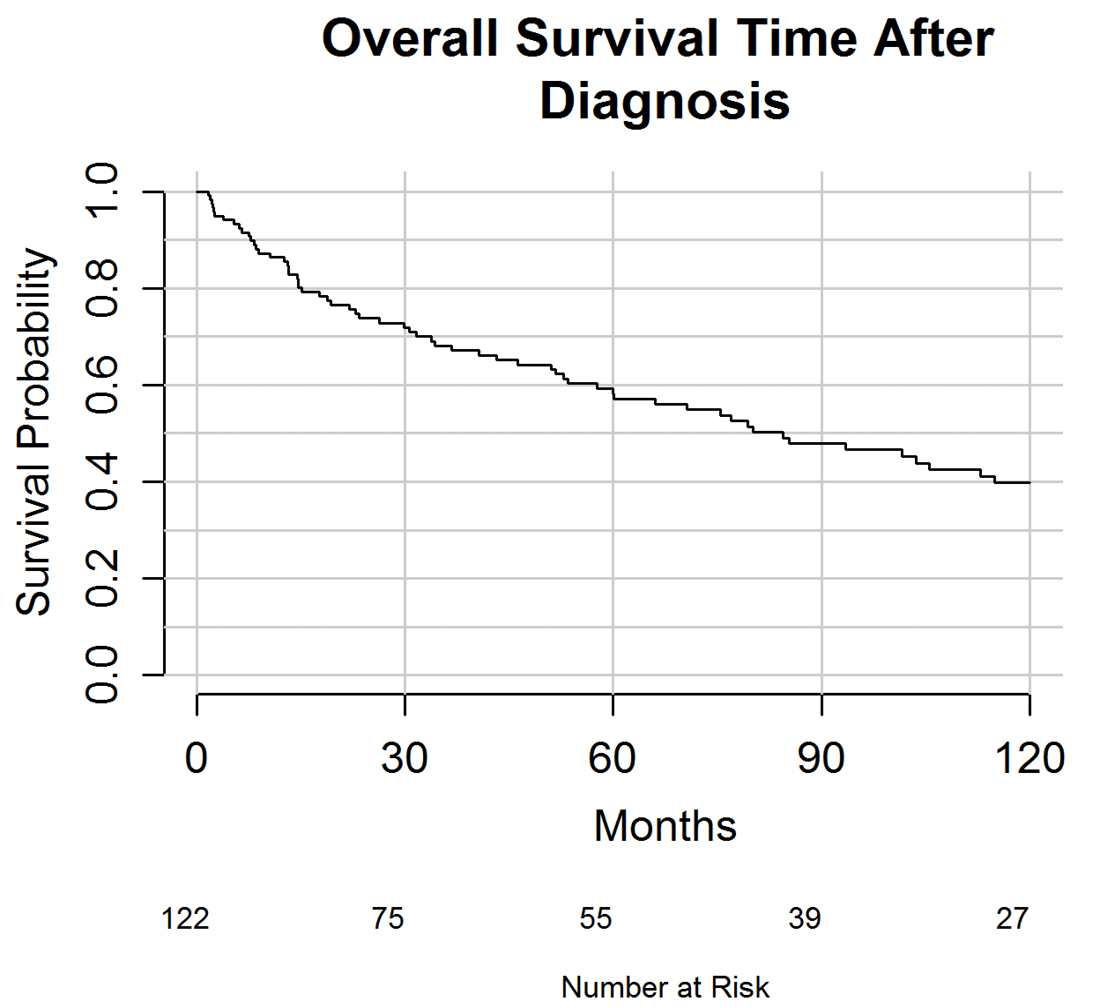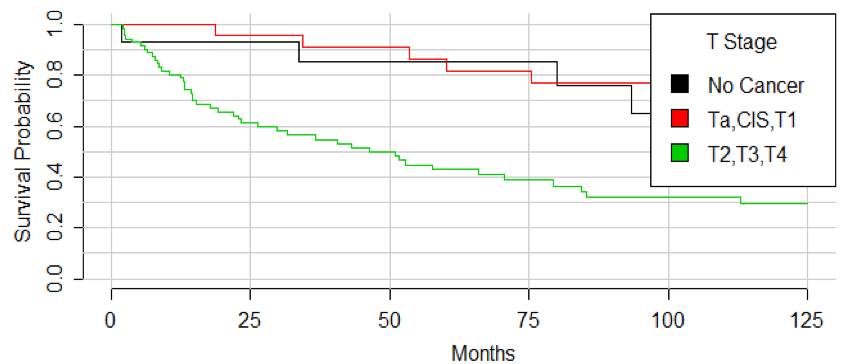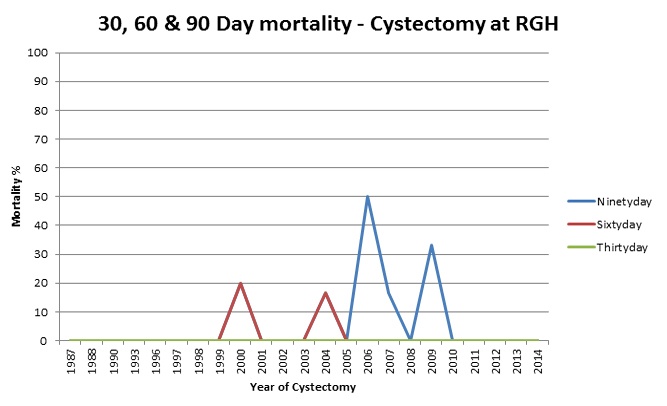Cystectomy survival outcomes: A single center experience in Australia

Objective: Survival following cystectomy is influenced by gender, age and initial pathology. We report on variation in biopsy versus final surgical pathology and its impact on survival, five year survival of those undergoing cystectomy for bladder urothelial carcinoma, and evaluate any difference between gender and age.
Methods: Patients were selected from our hospital cancer database who underwent a cystectomy for bladder urothelial carcinoma between 1987 and 2015. Patients were considered as having bladder cancer if they had muscle invasive cancer, non-muscle invasive cancer or carcinoma in situ on their final biopsy pathology. Pathology was recorded at last cystoscopy before surgery and based on surgical specimen.
Results: One hundred and twenty-five patients were included, 71% male, and 29% female, with a median age at cystectomy of 67.1 years. Fifty-seven point nine percent of patients had no change between their biopsy and cystectomy histopathology and 18.3% of patients were downgraded, 16.6% of patients were upgraded, and 7.1% had incomplete pathology data. Median survival was 4.6 years and overall five year survival 58.2%. There was no significant difference in survival between genders and no difference when comparing between gender and age > 70 and < 70 years. There was no statistical difference in survival between patients who had their final pathology upgraded, downgraded, or confirmed.
Conclusions: We found lower rates of variation in biopsy versus surgical pathology than reported elsewhere and did not observe a significant association with survival. Our survival outcomes are similar to those within the literature. Gender did not impact on survival, even when comparing between age > 70 and < 70 years.
Introduction

Patients and Methods
Statistical analysis
Results

| Median (IQR) | n (%) | |
|---|---|---|
| Age at diagnosis | 67.1 (60.29, 75.15) | |
| Age at operation | 69.2 (62.1, 76.6) | |
| Male | 90 (71.4) | |
| Female | 36 (28.6) | |
| BCG - Yes | 36 (28.6) | |
| BCG - No | 90 (71.4) | |
| Death events | 67 (53.6) | |
| Bladder urothelial carcinoma death events | 45 (36) | |
| Median survival (years) | 4.6 (1.21, 9.2) | |
| Neoadjuvant chemotherapy following MDT | 15 (20) | |
| Pathology pre-cystectomy | ||
| CIS | 21 (17) | |
| pT1 | 15 (12) | |
| pT2 | 41 (33) | |
| pT3 | 28 (22) | |
| pT4 | 12 (10) | |
| Final surgical pathology | ||
| No cancer | 16 (12.7) | |
| NMIBC | 26 (20.6) | |
| Muscle invasive | 75 (59.5) | |
| No information | 9 (7.1) | |
| Lymph node status | ||
| Patients with positive lymph nodes | 21 (16.6) | |
| Patients with negative lymph nodes | 66 (52.4) | |
| Missing data | 39 (31.4) |
| HR (95%CI) | P value | |
|---|---|---|
| Model 1* | ||
| Upgrade | 1.63 (0.90–2.96) | 0.11 |
| Downgrade | 0.80 (0.90–1.63) | 0.54 |
| Model 2** | ||
| Upgrade | 1.09 (0.58–2.05) | 0.79 |
| Downgrade | 0.84 (0.41–1.73) | 0.64 |
**Model 2 includes Model 1 and LVI status.
| Pre-cystectomy pathology | Downgraded | Unchanged | Upgraded |
|---|---|---|---|
| Ta, CIS, T1 | 5 (20%) | 20 (80%) | 0 |
| T2, T3, T4 | 2 (2.7%) | 51 (68.9%) | 21 (28.4%) |

Discussion
-
-
Australian Institute of Health and Welfare (2013) Cancer survival and prevalence in Australia: period estimates from 1982 to 2010. Asia Pac J Clin Oncol 9:29-39. doi: https://doi.org/10.1111/ajco.12062. [View Article] [PubMed][Google Scholar]
-
Scelo G, Brennan P (2007) The epidemiology of bladder and kidney cancer. Nat Rev Urol 4: 205-217. doi: https://doi.org/10.1038/ncpuro0760. [View Article] [PubMed] [Google Scholar]
-
Tracey E, Roder D, Luke C, Bishop J (2009) Bladder cancer survivals in New South Wales, Australia: why do women have poorer survival than men?. BJU Int 104: 498-504. doi: https://doi.org/10.1111/j.1464-410X.2009.08527.x. [View Article] [PubMed] [Google Scholar]
-
Marks P, Soave A, Shariat SF, Fajkovic H, Fisch M, et al. (2016) Female with bladder cancer: what and why is there a difference?. Transl Androl Urol 5: 668-682. doi: https://doi.org/10.21037/tau.2016.03.22. [View Article] [PubMed] [Google Scholar]
-
Babjuk M, Böhle A, Burger M, Compérat E, Kaasinen E, et al. European Association of Urology (2015) Guidelines of non-muscle invasive bladder cancer (Ta, T1, and CIS). [Google Scholar]
-
Shariat SF, Palapattu GS, Karakiewicz PI, Rogers CG, Vazina A, et al. (2006) Discrepancy between clinical and pathologic stage: impact on prognosis after radical cystectomy. Eur Urol 51: 137-149. doi: https://doi.org/10.1016/j.eururo.2006.05.021. [View Article] [PubMed] [Google Scholar]
-
May M, Brookman-Amissah S, Roigas J, Hartmann A, Störkel S, et al. (2009) Prognostic accuracy of individual uropathologists in noninvasive urinary bladder carcinoma: a multicentre study comparing the 1973 and 2004 World Health Organisation classifications. Eur Urol 57: 850-858. doi: https://doi.org/10.1016/j.eururo.2009.03.052. [View Article] [PubMed] [Google Scholar]
-
Van Der Meijden A, Sylvester R, Collette L, Bono A, Ten Kate F (2000) The role and impact of pathology review on stage and grade assessment of stages Ta and T1 bladder tumors: a combined analysis of 5 European Organization for Research and Treatment of Cancer Trials. J Urol 164: 1533-1537. [PubMed] [Google Scholar]
-
Miladi M, Peyromaure M, Zerbib M, Saighi D, Debre B (2003) The value of a second transurethral resection in evaluating patients with bladder tumours. Eur Urol 43: 241-245. [PubMed] [Google Scholar]
-
Herr HW, Donat SM (2008) Quality control in transurethral resection of bladder tumours. BJU Int. 2008;102(9 Pt 102: 1242-6.[Google Scholar]
-
Murphy WM, Takezawa K, Maruniak NA (2002) Interobserver discrepancy using the 1998 World Health Organization/International Society of Urologic Pathology classification of urothelial neoplasms: practical choices for patient care. J Urol 168: 968-972. doi: https://doi.org/10.1097/01.ju.0000024393.13257.3b. [View Article] [PubMed] [Google Scholar]
-
Witjes JA, Moonen PMJ, van der Heijden AG (2006) Review pathology in a diagnostic bladder cancer trial: effect of patient risk category. Urology 67: 751-755. doi: https://doi.org/10.1016/j.urology.2005.10.028. [View Article] [PubMed] [Google Scholar]
-
Patel HD, Ball MW, Cohen JE, Kates M, Pierorazio PM, et al. (2015) Morbidity of urologic surgical procedures: an analysis of rates, risk factors, and outcomes. Urology 85: 552-559. doi: https://doi.org/10.1016/j.urology.2014.11.034. [View Article] [PubMed] [Google Scholar]
-
Hounsome LS, Verne J, McGrath JS, Gillatt DA (2014) Trends in operative caseload and mortality rates after radical cystectomy for bladder cancer in England for 1998-2010. Eur Urol 67: 1056-1062. doi: https://doi.org/10.1016/j.eururo.2014.12.002. [View Article] [PubMed] [Google Scholar]
-
Ahmadi N, Delprado WJ, Brooks AJ, Brenner PC, Coombes GM, et al. (2014) Pathological evaluation and quality of surgery in radical cystectomy in New South Wales, Australia. ANZ J Surg 85: 145-149. doi: https://doi.org/10.1111/ans.12383. [View Article] [PubMed] [Google Scholar]
-
Shariat SF, Svatek RS, Tilki D, Skinner E, Karakiewicz PI, et al. (2010) International validation of the prognostic value of lymphovascular invasion in patients treated with radical cystectomy. BJU Int 105: 1402-1412. doi: https://doi.org/10.1111/j.1464-410X.2010.09217.x. [View Article] [PubMed] [Google Scholar]
-
Margulis V, Lotan Y, Montorsi F, Shariat SF (2008) Predicting survival after radical cystectomy for bladder cancer. BJU Int 102: 15-22. doi: https://doi.org/10.1111/j.1464-410X.2008.07594.x. [View Article] [PubMed] [Google Scholar]
-
Patel MI, Bang A, Gillatt D, Smith DP (2015) Contemporary radical cystectomy outcomes in patients with invasive bladder cancer: a population-based study. BJU Int 116 Suppl 3: 18-25. doi: https://doi.org/10.1111/bju.13152. [View Article] [PubMed] [Google Scholar]
-
Patel MI, Bang A, Gillett D, Cheluvappa R, Smith DP (2015) Poor survival of females with bladder cancer is limited to those aged 70 years or over: a population-wide linkage study, New South Wales, Australia. Cancer Med 4: 1145-1152. doi: https://doi.org/10.1002/cam4.452. [View Article] [PubMed] [Google Scholar]
-
Grambsch PM, Therneau TM (1994) Proportional hazards tests and diagnostics based on weighted residuals. Biometrika 81: 515-526.[Google Scholar]
-
R Development Core Team (2013) R: A language and environment for statistical computing. Vienna, Austria: the R Foundation for Statistical Computing. ISBN: 3-900051-07-0. Available online at http://www.R-project.org/. [Google Scholar]
-
Ploussard G, Shariat SF, Dragomir A, Kluth LA, Xylinas E, et al. (2013) Conditional survival after radical cystectomy for bladder cancer: evidence for a patient changing risk profile over time. Eur Urol 66: 361-370. doi: https://doi.org/10.1016/j.eururo.2013.09.050. [View Article] [PubMed] [Google Scholar]
-
Gray PJ, Lin CC, Jemal A, Shipley WU, Fedewa SA, et al. (2014) Clinical-pathologic stage discrepancy in bladder cancer patients treated with radical cystectomy: results from the national cancer data base. Int J Radiat Oncol Biol Phys 88: 1048-56. doi: https://doi.org/10.1016/j.ijrobp.2014.01.001. [View Article] [PubMed] [Google Scholar]
-
Svatek RS, Shariat SF, Novara G, Skinner EC, Fradet Y, et al. (2011) Discrepancy between clinical and pathological stage: external validation of the impact on prognosis in an international radical cystectomy cohort. BJU Int 107: 898-904. doi: https://doi.org/10.1111/j.1464-410X.2010.09628.x. [View Article] [PubMed] [Google Scholar]
-
Mitra AP, Skinner EC, Schuckman AK, Quinn DI, Dorff TB, et al. (2014) Effect of gender on outcomes following radical cystectomy for urothelial carcinoma of the bladder: a critical analysis of 1,994 patients. Urol Oncol 32: 51-52. doi: https://doi.org/10.1016/j.urolonc.2013.08.007. [View Article] [PubMed] [Google Scholar]
-
Birkmeyer JD, Siewers AE, Finlayson EV, Stukel TA, Lucas FL, et al. (2002) Hospital volume and surgical mortality in the United States. N Engl J Med 346: 1128-1137. doi: https://doi.org/10.1056/NEJMsa012337. [View Article] [PubMed] [Google Scholar]
-
Begg CB, Cramer LD, Hoskins WJ, Brennan MF (1998) Impact of hospital volume on operative mortality for major cancer surgery. JAMA 280: 1747-1751. [PubMed] [Google Scholar]
-
Dudley RA, Johansen KL, Brand R, Rennie DJ, Milstein A (2000) Selective referral to high-volume hospitals: estimating potentially avoidable deaths. JAMA 283: 1159-1166. [PubMed] [Google Scholar]
-
Halm EA, Lee C, Chassin MR (2002) Is volume related to outcome in health care? A systematic review and methodologic critique of the literature. Ann Intern Med 137: 511-520. doi: https://doi.org/10.7326/0003-4819-137-6-200209170-00012. [View Article] [PubMed] [Google Scholar]
-
Birkmeyer JD, Sun Y, Wong SL, Stukel TA (2007) Hospital volume and late survival after cancer surgery. Ann Surg 245: 777-783. doi: https://doi.org/10.1097/01.sla.0000252402.33814.dd. [View Article] [PubMed] [Google Scholar]
-
Finks JF, Osborne NH, Birkmeyer JD (2011) Trends in hospital volume and operative mortality for high-risk surgery. N Engl J Med 364: 2128-2237. doi: https://doi.org/10.1056/NEJMsa1010705. [View Article] [PubMed] [Google Scholar]
-
Roupret M, Yates DR, Varinot J, Phe V, Chartier-Kastler E, et al. (2012) The presence of detrusor muscle in the pathological specimen after transurethral resection of primary pT1 bladder tumors and its relationship to operator experience. Can J Urol 19: 6459-6464. [PubMed] [Google Scholar]
-
Capogrosso P, Capitanio U, Ventimiglia E, Boeri L, Briganti A, et al. (2015) Detrusor muscle in TUR-derived bladder tumor specimens: Can we actually improve the surgical quality?. J Endourol 30: 400-405. doi: https://doi.org/10.1089/end.2015.0591. [View Article] [PubMed] [Google Scholar]
-
Shoshany O, Mano R, Margel D, Baniel J, Yossepowitch O (2014) Presence of detrusor muscle in bladder tumor specimens--predictors and effect on outcome as a measure of resection quality. Urol Oncol 32: 40. doi: https://doi.org/10.1016/j.urolonc.2013.04.009. [View Article] [PubMed] [Google Scholar]
-

